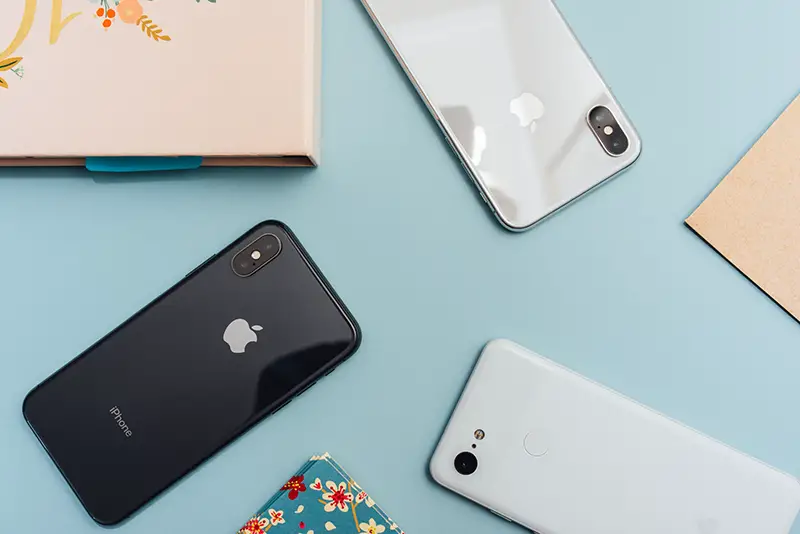Click here to get this post in PDF
When the iPhone X was released, comparisons with the model it was replacing, the iPhone 8, were rife. Most people wanted to see the value between them both, and as is typical, most wanted to find a justification for sticking with their iPhone 8’s home button. It has been a few years since both were availed to us but do the comparisons still make sense. Is the iPhone 8 design still relevant today? Which iPhone has aged better? Which model makes a better buy as a refurbished device? Let’s look at the specs that make the iPhone X and 8 and decide which one is the best to buy and if you’re on a budget, buying a refurbished iPhone from Phonebot is your best bet.
Design
The iPhone 8 is a familiar design that only changes by the entry of the iPhone X into the iPhone line-up. It has top and bottom bezels denoted by a home button which is a stark contrast to the thin bezels of the iPhone X. They share almost the same footprint, but the iPhone X feels like the larger smartphone thanks to a larger display and higher screen to body ratio. The iPhone X gets rid of the home button, which gives the phone a sleeker, less fussy look compared to the iPhone 8. Because of this, navigation on the iPhone X is done via gestures, some of which are in the iPhone 8 but after some time using the phone, the gestures feel intuitive and natural. Both phones were released in the same year, —2017, but the iPhone X feels more futuristics, partly because it is the design philosophy of the recent iPhones.
Display
The iPhone 8 has a retina IPS LCD display capable of the same 625 nit brightness as the iPhone X, but that is as far as the comparisons go display-wise. Despite having almost similar sizes, the iPhone X sports a 5.8-inch Super Retina HD display compared to a 4.7-inch Retina HD display on the iPhone 8. While the iPhone 8’s LCD panel can only has 401 pixels per inch (PPI), the Super Retina OLED display panel on the iPhone X has 458 PPI. The iPhone X’s display is also capable of HDR10 and Dolby Vision on top of Apple’s TrueTone display technology. The advantage of the OLED display is indisputable. It has better color accuracy, a bigger contrast ratio, and a wider viewing angle. It also has a better dark and black color, and thanks to the HDR feature, the colors are brighter, clearer, and crisper.
Cameras
The iPhone 8 has a single camera at the back, but the iPhone X comes with a dual-camera setup. The iPhone X combines an f/1.8 wide-angle and f/2.4 telephoto shooters, both of which deliver stunning photos and improved low light performance over the iPhone 8. Portrait mode—where the foreground is in sharp focus, and the back is blurred, is a welcome feature of the iPhone X. But that’s what you get with two brilliant cameras. Optical image stabilization (OIS) is standard on both lenses of the iPhone, which also makes it easy to shoot moving images without having to spend much time focusing. Despite both being 7MP on the front camera, the iPhone X has a TrueDepth front camera with portrait lighting and portrait mode abilities. To say the least, your selfies will have a sharper foreground and intelligently blur the background to create stunning shots and a bokeh effect as if you were using the two rear cameras.
Performance
The iPhone 8 and iPhone X use the same 10nm A11 bionic chip. They also both feature a hexacore processor bit that also comes with a three-core GPU. While the chips may be the same, it is how they are used that shows the difference between the devices. The 64-bit A11 Bionic chip is powerful hence the reason apple used it to advance image processing and to execute the FaceID on the iPhone X. While it may look like a loss to miss TouchID, the simplicity of FaceID is unmatched. If you always have greasy hands, wet palms, and other similar characteristics, you will love raising your phone to your face and beginning to use it. While it was still in infancy on the iPhone X, it has gone on to be updated to become a safe and secure way of locking a phone with subsequent software updates. You should also look for sustainability when buying refurbished phones.
Battery
The iPhone X has a slightly bigger battery than the one on the iPhone 8. At 2,716mAh compared to 2,691mAh, the differences in battery life are marginal. Both are capable of up to 60h of music playback and can charge wirelessly. Unlike the iPhone 12, which has MagSafe charging in addition to wireless charging, both these phones are only capable of 15W fast charging and reaching 50% battery capacity with 30 minutes charge.
Final thoughts
The iPhone X ushered in the new age of the iPhone, and it has features like portrait mode, a huge screen to body ratio, and gesture control which works a treat. That said, the iPhone 8 is still a decent phone, and because they share the same chipset, the performance of the iPhone X is similar. Both phones will still receive software updates from Apple, which makes the great refurbished devices. So, if you want to get these premium features at a bargain, a refurbished iPhone X or iPhone 8 is worth your consideration.
You may also like: How to Switch from iPhone to Android [Easier Than Ever Before]
Image source: Unsplash.com

